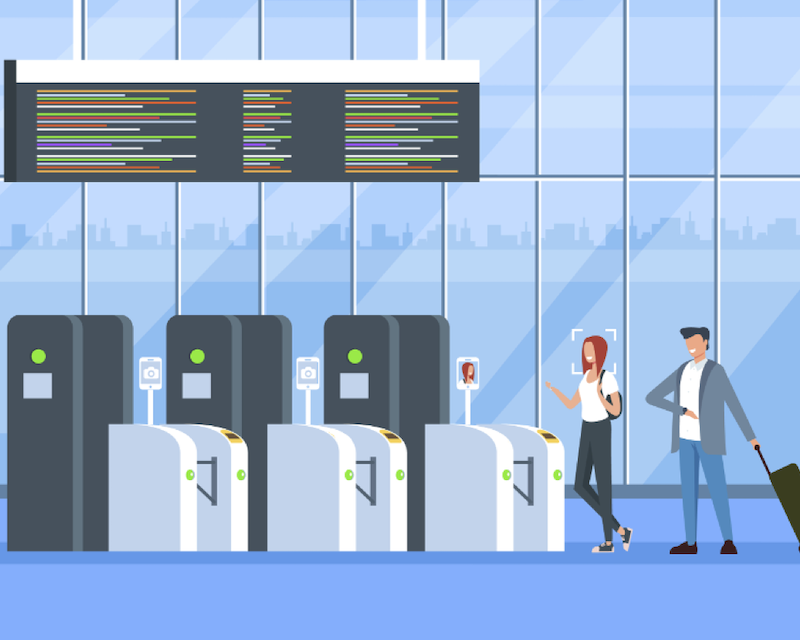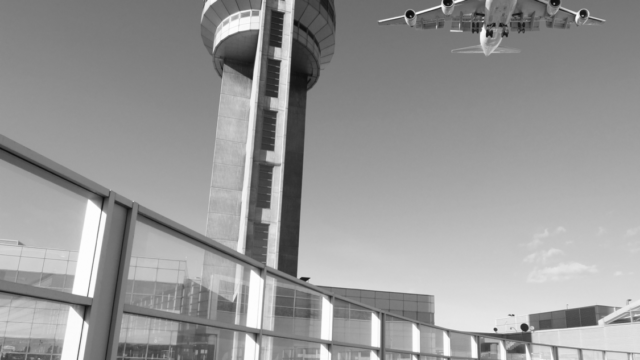
Could COVID-19 Give Biometrics the All-Clear?
Over the past few uncertain months, aviation leaders have been diligently working to mitigate the risks presented to their employees, passengers, and shareholders by COVID-19.
In lieu of definitive and specific long-term guidance from government authorities, leaders have been racing to identify and evaluate the right technology, procedural changes, and facility changes for protecting their employees and passengers moving forward. One such technology being especially promoted by integrators and OEMs is biometric facial recognition.
Respecting that facial recognition and other biometric technologies have offered various value propositions for years, there have been numerous hurdles hindering sustainable U.S. adoption prior to COVID-19. Could COVID-19 change this?
There were numerous hurdles hindering sustainable U.S. adaption of biometrics.
How We Got Here
Biometrics are not new to U.S. airports. Biometrics have been in use for years, including for employee background checks, verifying the identity of foreign nationals at immigration, and facilitating premium services. But these biometric applications were relatively small compared to an initiative trying to advance just prior to COVID-19.
For the past few years U.S. Customs and Border Protection (CBP) have been working to implement a major biometrics program in the U.S. While their program was triggered by a 9/11 Commission mandate for foreign nationals to be biometrically verified on exit from the U.S., other airport stakeholders started to recognize the impact the technology could have on other passenger touchpoints.
The Promise Prior to COVID-19
Passengers flying in and through the U.S. have forever been required to assert their identity multiple times, and those identity verifications have always been carried out manually by airline, TSA, and other airport staff.
With biometrics these identity checks can be automated, which carries various value propositions.
Efficiency
By automating identity checks, staff have the time and ability to be more productive. This is an advantage for airlines who are operating against razor thin financial margins, as well as the TSA, who often faces frontline staffing challenges.
Such automation also allows airport terminal and concourse operators to grow capacity within existing physical constraints. Faster process transaction times generally means more transactions per hour (i.e. higher declarable / schedulable airport capacity).
Security
Federal, state, and local law enforcement agencies have been confirming the increased effectiveness of biometrics in identifying and apprehending impersonators, as biometrics achieve lower false acceptance (i.e. misidentification) rates than humans performing similar checks.
Such automation also allows airport stakeholders to consider otherwise financially infeasible security. For example, there would be excessive cost and operational implications resulting from the construction of physical emigration departure checks for CBP as compared to integrating with airline checks at the boarding gate.
Revenue
Aviation and non-aviation retail specialists have found that reduced waiting times and simplified experiences point to higher discretionary spend by passengers. Biometrics enable more personalized experiences and offerings to be made to passengers, again resulting in increased revenue.
The New Promise
Facial (and iris) biometric recognition provides passengers the ability to go touch-free and paperless.
A quintessential germ hot spot that almost all passengers are familiar with is an airline’s check-in kiosk. Biometrics can help replace such traditional interactions with touch-free experiences, reducing the risk of passengers spreading germs to one another.
Hands-free experiences also reduce the risk of germs spreading from passengers to employees and vice-versa. A perfect example is the ID check performed by TSA personnel; while other temporary solutions may go in place for protecting TSA’s Travel Document Checkers (TDC), the recurring exchange of documents and mobile devices passenger after passenger still leaves both passengers and staff exposed.
Facial (and iris) biometric recognition provides passengers the ability to go touch-free and paperless
Finally, biometrics could be the key for a more timely and safe administration, and use, of ‘immunity passports’, which are currently under consideration by some governments. While antibody testing may help in identifying those that had and/or may be immune to COVID-19, distributing the associated credentials in paper form would be a counterproductive (and ironic) health and safety risk.
So, What is the Problem?
While U.S. momentum and vision for biometrics was growing prior COVID-19, most U.S. airlines were struggling to embrace full-scale biometric adoption. Some attributed this stagnation to U.S. Congress and its growing scrutiny over the ‘correct’ course of regulatory action concerning biometrics, but other headwinds existed.
Financial Challenges
- Many biometric solutions are still capital intensive and financially challenging to scale, operate, and maintain across the U.S.’s large aviation system.
- Regardless of the investment size, other potential airline and airport investments compete for the same, finite funds. In light of economic issues brought on by COVID-19, financial resources will be even more scarce.
- Even if biometrics were deployed, staff are still generally required to perform other tasks (e.g. TSA chain-of-custody requirements at bag-drop, airline gate agent pre- and post-flight duties). Staff are still often needed to assist with early phases of implementation due to passenger unfamiliarity with biometrics.
- Fiscal liabilities, in case of legal action, were a concern for some stakeholders.
Operational Challenges
- Reference biometric data is still not accessible to all key stakeholders, nor for all passengers (consider that CBP’s solution only serves passengers traveling internationally).
- Physically sorting passengers with biometrics on file from those without is complex due to the physical constraints of many airport facilities.
- Passengers wishing to opt-out require additional procedures, which impacts the operational savings (and now health protections) that would occur with just one standard procedure.
- The decision over eGates vs. camera-on-a-stick presents different operational requirements to be considered.
- Most facilities were not designed and sized to accommodate biometric-enabled processing (especially if targeting an eGate option).
- Capacity scheduling, especially around aircraft gates, reaches a new level of complexity in cases where gates are not all equipped with biometrics (most gates handle both international and domestic flights).
- Rules and procedures still need to be enforced which often requires staff, which can negatively impact the operational, financial, and now health benefits of biometrics.
- Implications of biometric system outages are severe given the normal time criticality of passenger and aircraft departures.
Most U.S. airlines are struggling to embrace full-scale biometric adoption.
Technical Challenges
- No human or system is perfect, but there has been an expectation by some that biometrics must achieve this standard in order to be worth adopting; no captures, false rejections, and false acceptances still exist with biometrics
- Environmental conditions (e.g. glare, lighting, reflections) still have a negative impact on biometric capture quality and consequently match rate.
- Performance varies depending on the passenger population and whether it is being leveraged for 1-to-1 matching, 1-to-few matching, or 1-to-many matching against on-file biometric data.
- Integration with airline departure control systems and common use equipment isn’t always a given; some vendors have conflicts of interest when they sell both common use and biometric solutions.
- Universal design standards are still being developed.
- Protection of any data is complex and not guaranteed. Implications from compromised biometric data are still being evaluated.
Legal Challenges
- Laws and regulations related to personal data ownership and obligations are still evolving.
- Some believe that existing federal, state, local, and international laws and regulations will expand in their restrictions over biometrics.
- Federal laws and regulations sometimes overlap and/or contradict state laws and regulations, as well as international ones.
- Moving TSA from its current pilots to a fully implemented biometrics program would be a lengthy process involving many complex issues and the need for additional rule-making.
- The use of facial recognition and the applicability of biometrics to U.S. citizens as they enter and leave the country have been open controversial issues for CBP.
Passenger Challenges
- While frequent flyers are generally more familiar with biometrics, non-frequent flyers often do not share the same awareness (i.e. extra education required to ensure understanding as well as feelings of trust and comfort).
- Elected officials (i.e. U.S. Congressional members and state / local government officials) have been voicing concerns on behalf of their constituents.
- Influential privacy groups have been voicing multiple concerns.
- Influential media, echoing both those promoting but also those concerned with biometrics, have been creating confusion.
What Still Needs to Happen
Proponents of biometric technology have been actively searching for solutions to the multitude of challenges facing biometrics. And while there is no single solution to all these challenges, there is one solution that tackled the most important challenges.
Legally, private sector taking ownership as the identity provider for domestic passengers (i.e. those passengers not on international flights) is neither desired by stakeholders nor would be that easy due to evolving state and international data protection regulations. Similar to how CBP engineered its Traveler Verification Service (TVS), the right solution, legally, has government at the center.
Financially, the real case rests where identity checks are performed most frequently. Use of biometrics by the TSA at the checkpoint would achieve direct value as well as overcome challenges with CBP’s deployment of biometrics at boarding. Why add an identity check at boarding when you can synergize with one already performed by government at the checkpoint? The right solution financially (and operationally) depends on government, specifically the TSA.
The TSA hold the keys to U.S. aviation’s biometric castle.
Conclusions
While preparations for the imminent economic storm and the next pandemic rely on more than just biometrics, the technology could be a key component of a robust plan.
But such an initiative will only bring benefits if a TSA-integrated biometric solution is developed for all passengers. For this the U.S. Government must remain in the lead with oversight by U.S. Congress. And the TSA must be afforded the necessary authorities (and funding) to execute.
While such a feat would have previously been considered impossible by many, COVID-19’s fallout and ‘new norm’ may be the catalyst that the U.S. Government needs to address aviation’s biometrics problem.




